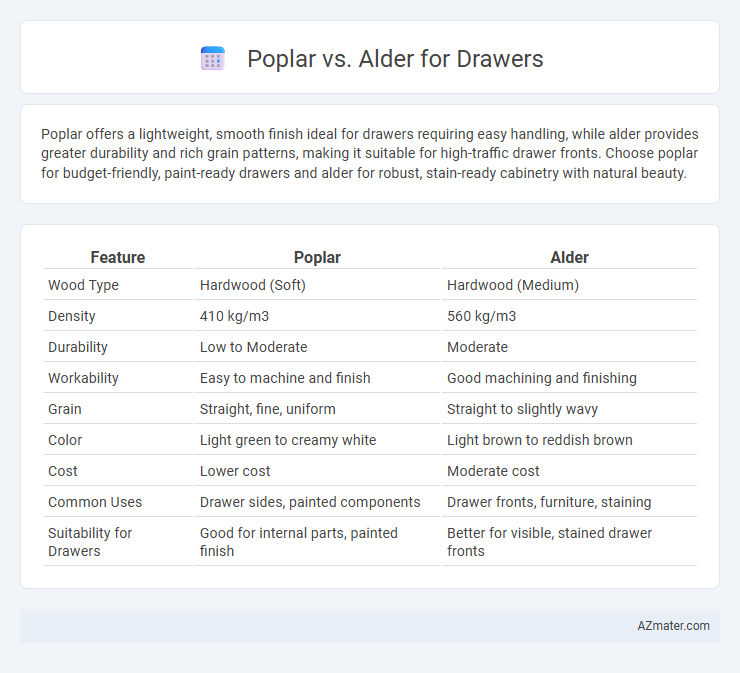Poplar offers a lightweight, smooth finish ideal for drawers requiring easy handling, while alder provides greater durability and rich grain patterns, making it suitable for high-traffic drawer fronts. Choose poplar for budget-friendly, paint-ready drawers and alder for robust, stain-ready cabinetry with natural beauty.
Table of Comparison
| Feature | Poplar | Alder |
|---|---|---|
| Wood Type | Hardwood (Soft) | Hardwood (Medium) |
| Density | 410 kg/m3 | 560 kg/m3 |
| Durability | Low to Moderate | Moderate |
| Workability | Easy to machine and finish | Good machining and finishing |
| Grain | Straight, fine, uniform | Straight to slightly wavy |
| Color | Light green to creamy white | Light brown to reddish brown |
| Cost | Lower cost | Moderate cost |
| Common Uses | Drawer sides, painted components | Drawer fronts, furniture, staining |
| Suitability for Drawers | Good for internal parts, painted finish | Better for visible, stained drawer fronts |
Poplar vs Alder for Drawer Construction: An Overview
Poplar offers a lightweight, stable option with smooth grain, making it ideal for drawer construction requiring easy machining and uniform finishing. Alder provides a slightly harder, denser material with a warm reddish tone, suited for drawers demanding greater durability and attractive staining options. Both woods balance cost-efficiency and workability, but poplar's consistent texture benefits drawers with painted surfaces, while alder excels in natural or stained finishes.
Wood Hardness: Poplar vs Alder Durability
Alder wood typically has a Janka hardness of around 590, providing moderate durability suitable for drawer construction, while Poplar registers lower at approximately 540, making it softer and more prone to dents and scratches. The higher hardness of Alder contributes to better resistance against daily wear and tear, enhancing drawer longevity. Poplar's softness requires careful handling but offers ease of machining and finishing, which may be ideal for less-demanding drawer applications.
Grain Patterns and Aesthetics for Drawers
Poplar features a fine, straight grain with a smooth texture, making it ideal for drawers that require a uniform and paint-friendly surface. Alder has a more pronounced, open grain pattern with subtle knots, offering a warmer and rustic aesthetic suited for natural or stained finishes on drawers. Both woods provide good durability, but Alder's richer visual appeal makes it preferred for drawers aiming to showcase wood character.
Workability: Cutting and Shaping Poplar vs Alder
Poplar features a fine, uniform texture with a straight grain, making it easy to cut and shape using both hand and power tools, which enhances precision in drawer construction. Alder has a slightly denser grain but remains relatively soft, allowing it to be shaped and routed smoothly while providing a bit more durability. Both woods offer excellent workability for drawers, but Poplar's softer nature tends to be preferred for detailed cutting and intricate joinery.
Cost Comparison: Poplar vs Alder for Drawers
Poplar wood is generally more affordable than alder, making it a cost-effective option for drawers without compromising on strength. Alder tends to be pricier due to its finer grain and durability, which can increase the overall project budget. Choosing poplar helps reduce material costs, especially for large drawer units or budget-sensitive cabinetry projects.
Finishing Options and Stain Acceptance
Poplar offers a smooth surface that readily accepts paint, making it ideal for drawer finishing with high-quality, opaque stains or solid colors, though its natural grain may produce uneven stain absorption. Alder, on the other hand, has a finer grain and more consistent texture, allowing for superior stain acceptance that highlights its warm, reddish-brown tones with clear or semi-transparent stains. Both woods are suitable for drawer construction, but alder provides more predictable and rich finishing results with wood stains, while poplar excels with painted finishes.
Weight Differences: Poplar vs Alder Drawer Performance
Poplar, being lighter with a density around 25-30 lbs/ft3, offers easier handling and less strain on drawer slides compared to Alder, which has a higher density of about 34-44 lbs/ft3. This weight difference influences drawer performance by affecting smooth operation and durability under frequent use, with Alder providing more robustness but added stress on hardware. Choosing Poplar improves ease of installation and long-term efficiency, while Alder supports heavier loads but may require more durable drawer mechanisms.
Moisture Resistance and Stability
Poplar offers moderate moisture resistance and good dimensional stability, making it suitable for indoor drawers in controlled environments. Alder wood is less moisture-resistant but boasts better stability under fluctuating humidity, reducing warping over time. For drawer construction, alder provides a more reliable choice in areas prone to moisture variation, while poplar excels in dry, stable conditions.
Best Uses: Poplar or Alder for Drawer Applications
Poplar wood is ideal for drawer applications due to its smooth surface and excellent paint adhesion, making it perfect for painted or stained finishes in less visible areas. Alder offers greater durability and a beautiful natural grain, suitable for drawers that require strength and a warm aesthetic, especially in furniture with clear or natural finishes. Choosing between poplar and alder depends on whether the priority is cost-effectiveness and ease of finishing (poplar) or enhanced durability and appearance (alder) for drawer construction.
Expert Recommendations: Choosing Between Poplar and Alder for Drawers
Experts recommend choosing poplar for drawer construction due to its affordability, lightweight nature, and smooth grain ideal for painting and staining. Alder is favored for high-end drawers because of its durability, rich reddish-brown hues, and fine grain that enhances stain absorption for a luxurious finish. Ultimately, the decision hinges on budget constraints, desired aesthetics, and the drawer's functional requirements.

Infographic: Poplar vs Alder for Drawer
 azmater.com
azmater.com